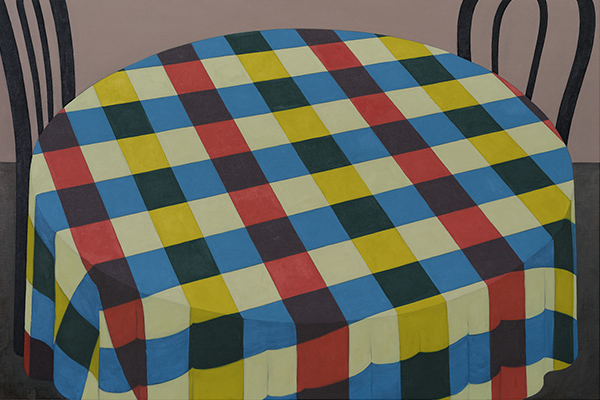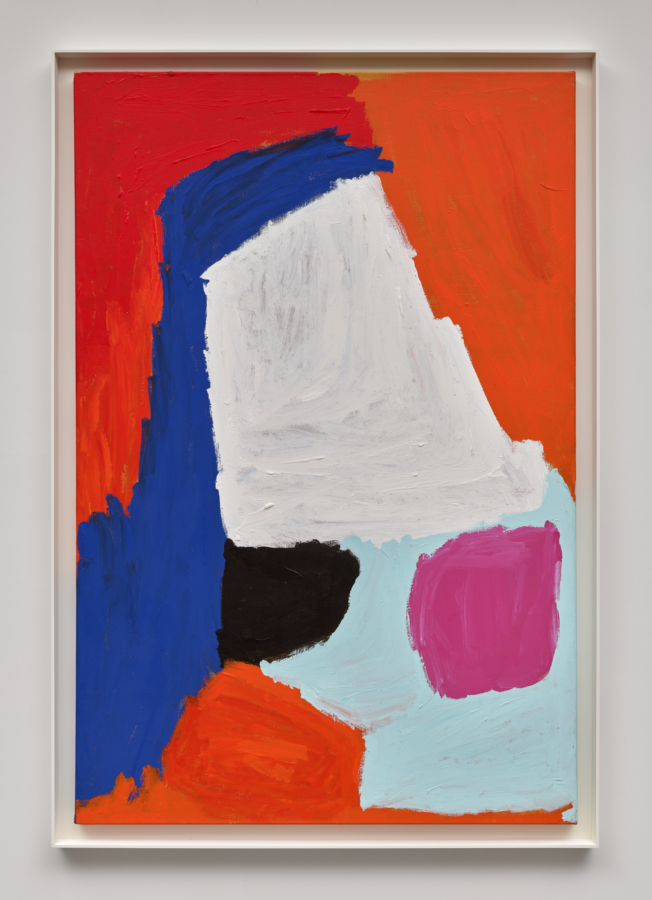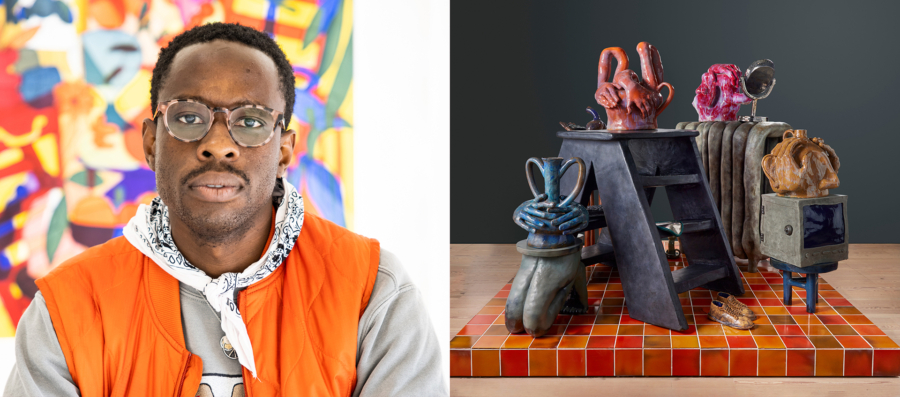2022
Kathleen Ryan, Daisy Chain, published by Karma, New York, 2022
Every November, porches, walkways, and stoops become the site of unplanned science experiments, with varying stages of rotting pumpkins unabashedly displayed. These remnants of festivities sit with increasingly lopsided grins, breaking down in unexpected ways, neglected, yet fecund, gradually merging with concrete or wood until someone remembers to put them in the compost or garbage. Sometimes they look perfectly fine from the outside, surprising someone with a wealth of new bacterial growth if they are curious enough to look inside. Encountering the giant version of this phenomenon is startling, and also rather humorous. Kathleen Ryan’s Jackie (2021) depicts a perfectly happy nearly-eight-foot-wide jack-o’-lantern, with its lid resting to one side. It seems uncharacteristically fresh upon first glance, but the inside bursts with various colors and stages of rot and mold. The humor, or maybe more pointedly, the irony, is compounded by the fact that upon closer inspection the giant pumpkin, like the other oversize rotting fruit for which Ryan has become known, is entirely beaded with gems, acrylics, and glass—all longlasting materials. Constructed in the same manner as kitsch fruit kits that were popular in postwar America, the collection of works titled Bad Fruit remain faithful to the crafting technique, with a basic foam armature meticulously beaded to resemble the various fruits. In these giant renditions, healthy flesh is composed of manufactured plastic and glass beads, whereas rot is depicted with semiprecious gemstones and healing crystals. Ryan explicitly makes decay itself valuable: the more advanced the state of decomposition, the more precious the stones used to depict that putrefaction. Bacteria and mold sparkle and glitter, joyously multiplying on the outsize, decadent fruit. The rot is teeming, threatening to release sticky juices, contaminating other biological matter nearby, barely containing the squishy insides. Yet the most potent reminder of rot—smell—is absent here, sanitizing and beautifying decay for artistic effect, asking the audience to look closer to the forms of purification. The hardness of what would be soft, yielding skins combining opposite potentials that playfully resound: a technique the artist has used throughout her work.
Bad Fruit—which, for this solo exhibition at Karma, includes five Bad Cherry sculptures and three Bad Lemons, in addition to the pumpkin—can be understood as a contemporary version of Dutch vanitas paintings from the early seventeenth century. Vanitas paintings are known for their display of imported and exotic fruit that often rotted during the process of painting, as a statement of luxury itself, for the fruit was indeed quite precious, gained through colonial exploitation. The decomposing fruit was often depicted with skulls and other objects as potent reminders of mortality and life’s renewal. In Bad Fruit, the tradition is extended into three dimensions as a critical commentary on the excesses of luxury and waste. Decay is not a simple idea in this work. Putrescence evokes a world in decline, where growing inequality speaks to a profound abandonment of the earth and all its beings. The artworks evoke the relationship between colonialism and advanced capitalism, by referencing the vanitas tradition re-presented for contemporary audiences, and the supposed necessity for boundless growth despite the obvious waste and rot involved. In fact, waste and rot continue to be the engines of capital gain and exploitation. Nothing, not even waste, is simply left to decay; it is itself turned into a process of commodification within the voracious economic system we find ourselves within, and these artworks are a potent reminder of that fact. The works also cannot be read apart from the art world within which they are situated, displaying how art itself is at the center of accumulation, consumption, waste, and inequality. They seem to invite a luxuriant nihilism, reveling in the waste, excesses, and decline of our present moment. And yet, beyond this pointed critique, there is also an excess that cannot be contained or corralled for economic gain. Decomposition offers the vision of another world being birthed, a putrescence that is completely alive, a multitudinous takeover of the singularity of each fruit. In particular, for this exhibition, the mold really does dominate, as the entire case of Bad Cherries (2021) has gone bad and the lemons look like they’ve been forgotten for months. The beauty of the stones, the explicit valorization of bacterial abundance, conveys a deep appreciation for the vivacity of life itself, and for the possibilities of transformation.
The sculptures also get at something important about an often unstated but deeply held belief embedded in artistic objects: the desire for them to last, untouched and untainted, forever. Museums put a huge amount of effort and energy into maintaining works in perfect condition. Everything from humidity and temperature controls, to glass cases, to the work of conservators is geared explicitly to the goal of indefinite preservation. Even works that were originally meant to transform over time, such as Robert Smithson’s iconic Spiral Jetty (1970), are now carefully protected and preserved. Visualizing the arrest of decay and decomposition through materials, such as acrylic and stone, that are incredibly long lasting, foregrounds these conservation practices that are often taken for granted. Yet there is a productive tension here. Even though a sculpture like Daisy Chain (2021) that is also included in the exhibition—a giant chain made to resemble a child’s wreath of flowers, constructed from gardening and industrial tools—might originally strike the viewer as freezing a moment of innocence in time indefinitely through its reliance upon various forms of plastic for its construction, the work, much like the armature used to create the giant fruit sculptures, is not as stable as might be imagined. Even the semiprecious stones, gems, and crystals may not be as permanent as received wisdom would have us think. Geology is often presumed to be fixed, and, certainly in relation to the lifespan of a ripe fruit or a human, it is. But if we take a longer view, we can see that even geology is not stable. Geology itself is neither eternal, unmoving, nor completely solid. Volcanoes and earthquakes are potent reminders of the way that the earth itself, our rocky foundation, is also in a state of flux, fluidity, and movement— that what might appear permanent and stable from our vantage point is actually constantly transforming. And so, the choice to use gems, stones, glass, and plastic beads might not only be a productive tension between stability of form and decomposition, but also shows the ways in which these two extremes themselves may not be entirely in opposition to each other, but instead dependent upon the view, or the timescale.
By using gems that some people believe can heal, and by configuring the rocks into the shape of life as abundance in decomposition, there is an implicit questioning of the boundary between life and nonlife. The rocks and gems within these works carry the most vitality, brilliance, and possibility for transmogrification, rendered as they are as tumultuous rot. They seem to challenge received notions that rocks themselves are inherently inert, inanimate, and neatly classifiable as nonlife. As Elizabeth Povinelli notes, the strict division between life and nonlife is increasingly being challenged by contemporary science that understands that all beings rely upon their environment, and cannot neatly be separated from it.1 Although it may be difficult to discern if a rock dies, it certainly has an origin. And it is thought that, for some kinds of rock, that origin is bacterial.2 So, Ryan’s artistic rendering of bacterial flourishing in rock may not just be a particularly effective form to communicate beauty, or a productive tension by juxtaposing two opposites, but may also point to certain scientific facts. The works question this neat division between life and nonlife, suggesting an animate quality within the rocks themselves.
The exhibition portrays a deep fascination with the profundity of objects that are both decadent and mundane. And there is an obvious delight in the materials themselves, both in the intricate construction of each sculpture, and in the feeling of repulsion and attraction of rotting fruit. Basking in the sensuality of materiality, Ryan creates a world that brings more attention to matter itself, how it is tied to systems of commodification and luxury, but also how it can never be entirely captured.
1 Elizabeth Povinelli, Geontologies: A Requiem to Late Liberalism (Durham, NC: Duke University Press, 2016), 43.
2 Ibid.



